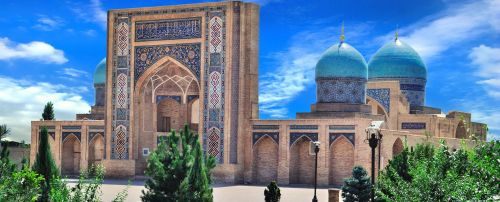Travel highlights Uzbekistan

Andijon
Andijon lies in the southeastern part of the Fergana Valley. The city, which stands on ancient deposits of the Andijon River, dates back at least to the 9th century. Andijon has lovely bazaars and chaikhanas which are worth a visit. The people are very friendly.
Bukhara
Bukhara, which is situated on the Silk Route, is more than 2,000 years old. It is the most complete example of a medieval city in Central Asia and is also considered one of Central Asia's holiest city. Bukhara has a wonderful old centre that probably hasn't changed much in two centuries. It is one of the best places in Central Asia for a glimpse of pre-Russian Turkestan.
Fergana Valley
The picturesque Ferghana Valley is located in the eastern part of Uzbekistan and is one big oasis. Already by the 2nd century BC the Greeks, Persians and Chinese found a prosperous kingdom based on farming, with some 70 towns and villages.
Khiva
Khiva's history is inextricably connected with the history of Turkmenistan, because the territory was part of the legendary Khorezmshah's State with its capital in Urgench before. Khiva is a very ancient city.In the 10th century Khive is mentioned as a major trading center on the Silk Road.Khiva - a unique city, rightfully claiming the title of "the seventh wonder of the world", thanks to its authentic atmosphere of the 'era of the beginning of time. " Most of the city of Khiva is similar to the open-air museum. And the nucleus of this museum - castle Itchan Kala.In 1990 the city was included in the UNESCO World Heritage List.
Nurata
The Nurata Mountains top out at just over 2000m, but are rapidly becoming, along with manmade Lake Aidarkul further north, the centre of Uzbekistan's growing ecotourism movement.Nurata is most famous for its old, circle-patterned suzani, which can sell for thousands of dollars at international auctions, but it also has a few quirky tourist attractions, most notably an old fortress of Alexander the Great.
Samarkand
No name is so evocative of the Silk Road as Samarkand. For most people it has the mythical resonance of Atlantis, fixed in the Western popular imagination by poets and playwrights of bygone eras, few of whom saw the city in the flesh.From the air your eye locks onto the domes and minarets, and on the ground the sublime, larger-than-life monuments of Timur, the technicolour bazaar and the city's long, rich history, indeed work some kind of magic. Surrounding these islands of majesty, modern Samarkand sprawls across acres of Soviet-built buildings, parks and broad avenues used by buzzing Daewoo taxis.You can visit most of Samarkand's high-profile attractions in two or three days. If you're short on time, at least see the Registan, Guri Amir, Bibi-Khanym Mosque and Shah-i-Zinda.